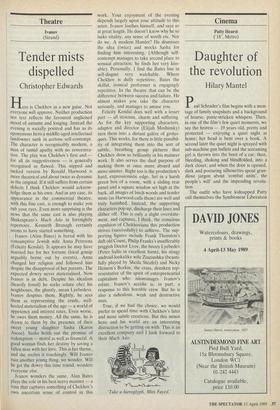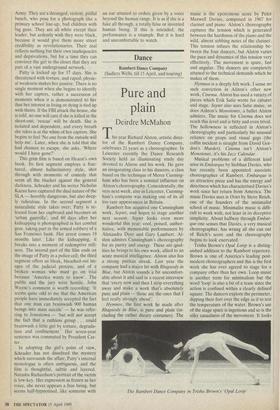Cinema
Patty Hearst (`18', Metro)
Daughter of the revolution
Hilary Mantel
Paul Schrader's film begins with a mon- tage of family snapshots and a background of hoarse, panic-stricken whispers. Then, in one of the film's few quiet moments, we see the heiress — 19 years old, pretty and protected — enjoying a quiet night at home; her head is bent over a book. A second later the quiet night is sprayed with sub-machine gun bullets and the screaming girl is thrown into the boot of a car; then, bleeding, shaking and blindfolded, into a dark closet; and when the door is opened, dark and posturing silhouettes spout gran- diose jargon about 'combat units', the people's will' and the impending revolu- tion.
The outfit who have kidnapped Patty call themselves the Symbionese Liberation Army. They are a deranged, violent, pitiful bunch, who pose for a photograph like a primary school line-up, bad children with big guns. They are all white except their leader, but ardently wish they were black, because it would give them more street credibility as revolutionaries. Their zeal reflects nothing but their own inadequacies and deprivations, but for a time they can convince the girl in the closet that they are part of a vast underground network.
Patty is locked up for 57 days. She is threatened with torture, and raped; physic- al weakness makes her passive. There is no single moment when she begins to identify with her captors, rather a succession of moments when it is demonstrated to her that her interest in living or dying is tied up with theirs. If the FBI attack the house, she is told, no one will care if she is killed in the shoot-out; 'rescue' will be death. She is isolated and dependent, and every breath she takes is at the whim of her captors. She begins to feel 'No one from the outside will help me'. Later, when she is told that she had chances to escape, she asks, 'Where would I have gone?'
This grim film is based on Hearst's own book. Its first segment employs a frac- tured, almost hallucinatory style, shot through with moments of comedy that seem all the blacker against the general darkness. Schrader and his writer Nicholas Kazan have captured the dual nature of the SLA — horribly dangerous, but also deep- ly ridiculous. In the second segment a naturalistic style takes over; Patty is re- leased from her cupboard and becomes an 'urban guerrilla', and 60 days after her kidnapping is photographed in her combat gear, taking part in the armed robbery of a San Francisco bank. Her arrest comes 19 months later. Like the kidnapping, it breaks into a moment of redemptive still- ness. The second part of the film ends on the image of Patty in a police cell; the third segment offers us bleak, bleached-out im- ages of the judicial process, and of a broken woman who must go on trial because 'America wants to know'. The public and the jury were hostile. John Wayne's comment is worth recording: 'It seems quite odd to me that the American people have immediately accepted the fact that one man can brainwash 900 human beings into mass suicide' — he was refer- ring to Jonestown — 'but will not accept the fact that a ruthless group . . . could brainwash a little girl by torture, degrada- tion and confinement.' Her seven-year sentence was commuted by President Car- ter.
In adopting the girl's point of view, Schrader has not dissolved the mystery which surrounds the affair; Patty's internal monologue is often ambiguous, and the film is thoughtful, subtle and layered. Natasha Richardson's portrait of the victim is low-key. Her expression as frozen as her voice, she never appears a free being, but seems half-hypnotised, like someone with
an ear attuned to orders given by a voice beyond the human range. It is as if she is a fake all through, a totally false or invented human being. If this is intended, the performance is a triumph. But it is hard and uncomfortable to watch.



















































 Previous page
Previous page